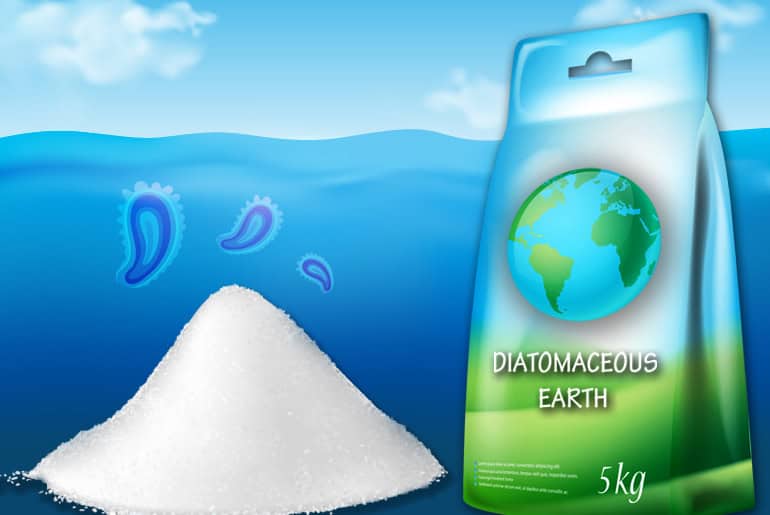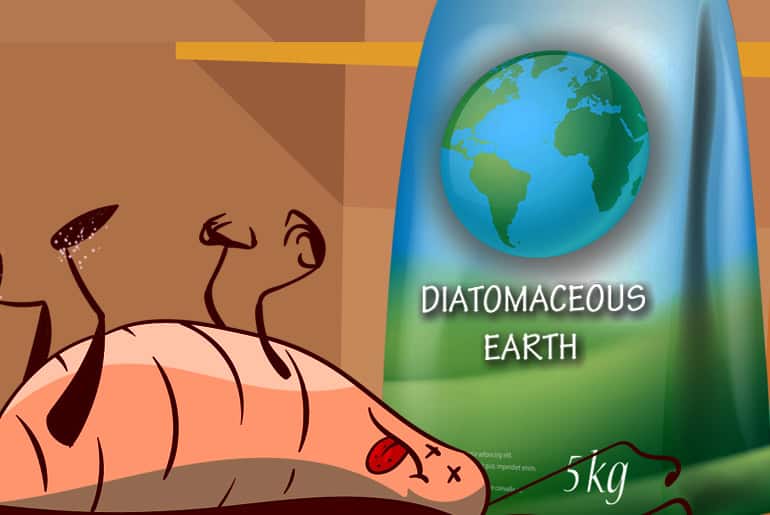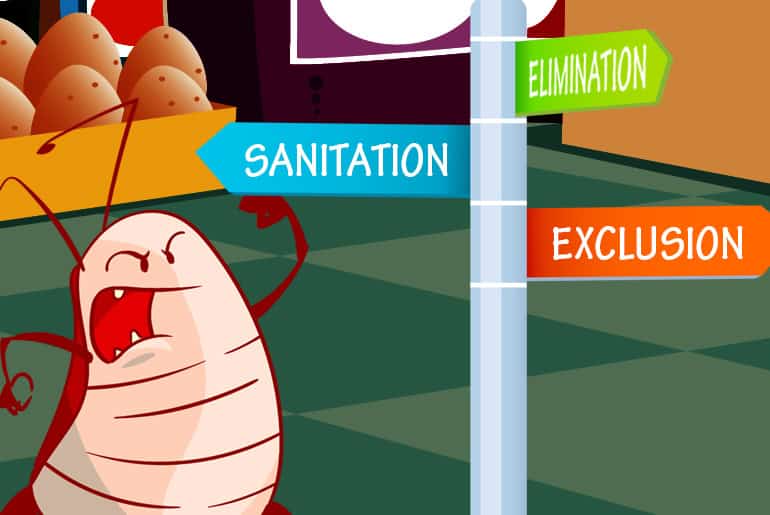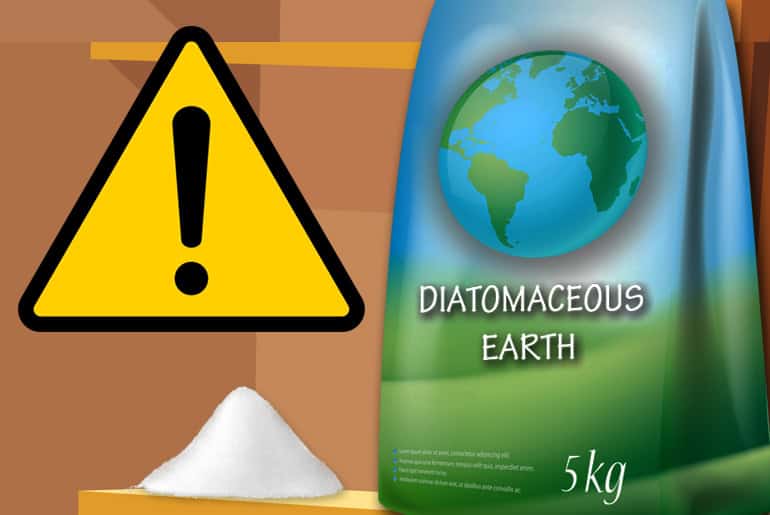Eliminating cockroaches doesn’t have to mean using harmful chemicals and putting your family and pets at risk.
Instead, use all-natural, non-toxic diatomaceous earth! Roaches don’t stand a chance against this dust and all you have to do is sprinkle it wherever you’ve seen them. It’s safe, cheap and easy to use!
Ready to learn the “how-to’s” of diatomaceous earth roach control? Let’s get started.
A Simple 5-Step Guide For Getting Rid of Roaches
“Print or Follow on Your Phone. It’s FREE!”
Remember, when using insecticides, the label is the law—read and follow the instructions carefully, not only for your own safety, but to make sure each treatment is as effective as possible.
Diatomaceous Earth Basics: What It Is and Where It Comes From

Diatomaceous earth (DE) is a fine dust created by grinding up the fossilized shells of diatoms, microscopic ocean organisms. It’s like sand but much finer and made of only one material.
Fun fact: If you thought there were a lot of cockroaches in the world, there are even more diatoms. They produce over 20% of all of the oxygen we breathe. Diatoms have existed for at least 200 million years—leave it to an organism that’s nearly as old as cockroaches themselves to be their weakness!
What do you use diatomaceous earth for?
DE is an ingredient in hundreds of products, from hardware and paint to personal care and even food. You’ll probably see the term “food grade” used with DE. Food grade diatomaceous earth is finer than other types—and it’s the kind you want to use.
Does Diatomaceous Earth Kill Roaches? Yes!

Diatomaceous earth kills a variety of insects, including cockroaches, fleas, ticks, bed bugs and more.
As both a preventative measure and an insecticide, it’s a fantastic home remedy for killing roaches. It seems too good to be true… but diatomaceous earth really works!
How Does Diatomaceous Earth Kill Cockroaches?
Diatomaceous earth powder is abrasive and breaks down the waxy layer of the cockroach’s hard exoskeleton, killing it through dehydration. When they walk through diatomaceous earth, roaches carry away some of the DE that clings to the tiny hairs on their legs. They typically die later, back at their nest.
Diatomaceous Earth & Cockroaches: Putting DE Powder to Use

One of the benefits of DE powder is its versatility. It’s easy to sprinkle or spray it behind appliances, under furniture, inside cupboards and even outside! Use food-grade DE in the kitchen on countertops and in cupboards. Since it’s easy to clean up with a vacuum, diatomaceous earth works for roaches in cars and trucks, too.
We recommend using a duster to apply diatomaceous earth. You don’t have to buy a specialized pest control duster, though; you can make your own duster by poking or drilling holes in the top of a 2-liter soda bottle. Then, simply fill it about halfway with DE dust, twist on the cap and squeeze to spray the dust through the holes.
Bonus: Do you like a dash of powdered sugar on your French toast or pancakes? Use that handy sugar shaker to sprinkle your DE mixture (but remember to wash it thoroughly after you’re done)!
In a pinch, you can also spread DE with a scoop. Maybe you have one for pet food or you got one with a bucket of ice melt—you can always use a spoon, (washing them later, of course) too!
How to Use Diatomaceous Earth for Roaches, Step-By-Step

Step 1: Clean and dry. DE needs to be dry to kill cockroaches. If you decide to clean before applying the DE, give the area a few minutes to dry. If the humidity is too high in your attic, basement or bathroom, use fans to reduce moisture before applying DE.
Step 2: Spread a thin coating. Apply a light coating of the DE dust on surfaces and in crevices where you’ve seen evidence of cockroaches. Focus on areas like the backsides of stoves, refrigerators, and other appliances where the bugs can find crumbs and other food sources. You can treat bathrooms and closets, too, if they’re not too humid.
Step 3: Hit roaches’ entry points. Dust inside of tiny spaces, including cracks, outlets and gaps around wiring. You’d be surprised at the number of places roaches can come from.
Step 4: Treat inside wall voids. If you find any cracks or holes leading into the walls, there’s a good chance roaches could be hiding in there. Luckily, your duster bottle makes it easy to blow the dust right through the hole. (If there’s no opening, drill a small hole near the ground or behind a decoration.)
Step 5: Try diatomaceous earth outside. Spread DE in the mulch, garden soil and grass around the perimeter of your house without worrying about damaging your landscaping! Just like you did inside, sprinkle a thin layer and let it do its job. Just try to pick out a few dry days from the weather forecast!
If you have a crawl space or similar space beneath your house (or under a deck, for example), roaches could nest there. One simple solution is to pour a pile of DE right at the entrance. Then, use a leaf blower or large fan to quickly dust the whole interior of the space. When spraying that much DE, wear a mask and goggles to avoid irritation (and to definitely avoid inhalation).
Step 6: Repeat and, hopefully, relax. Keep an eye on the places you’ve treated—the DE might need to be refreshed from time to time, depending on the conditions and the size of the cockroach infestation you’re fighting.
If it rains or seems too humid, you’ll have to reapply. If you’re facing a lot of roaches, try dusting twice per week. One study saw up to 80% effectiveness within 72 hours but a large infestation will take more ammunition.
Cleaning up DE is as easy as applying it.
Clean up diatomaceous earth by simply sweeping, wiping and vacuuming. Use a damp towel to wipe it off of surfaces and a broom and dustpan to sweep it off of wood and tile floors. Anywhere there’s carpeting, a vacuum will do the trick! Best of all, it doesn’t leave any dangerous chemicals behind.
Note: You don’t want to get DE into the air, so wipe and sweep gently. Also plan to switch out your regular vacuum cleaner bags for drywall or fine particle bags.
Make Diatomaceous Earth a Part of Your Total Pest Control Plan

Diatomaceous earth doesn’t have to be your only tool against cockroaches. It works even better in combination with other treatments.
Use gel baits along walls and save the DE for tiny cracks and crevices. Or, treat the inside of your home with DE and the outside with a residual spray.
Want another natural insecticide to use alongside DE? Boric acid (and the similar borax) is a similar-looking powdered roach killer that makes a solid sidekick for DE.
Boost your roach control plan further by using natural cockroach repellents in the areas where you’re not dusting with diatomaceous earth. Cockroaches will be driven away from these areas—possibly right into your DE minefields!
Finally, every pest control system has to include good cleaning and organizational habits to take away roaches’ food sources and some of their favorite hiding places. DE will eliminate your existing problem; your long-term game plan is prevention.
Caution: DE Can Still Cause Irritation and Shouldn’t Be Inhaled

Unlike filter-grade diatomaceous earth which contains 60% crystalline silica (a hazardous material associated with various lung diseases), food-grade DE contains less than 2% and is considered safe to use.
That said, you should keep the material away from small children and pets, and use goggles and a mask when applying it (the fine particles can irritate your lungs).
Conclusion
DE is a proven and easy-to-use part of a total pest control plan. With just a duster and some diatomaceous earth in your arsenal, roaches won’t know what hit them!
Good luck!
Frequently Asked Questions
Too much DE in one area is bad—it could scare the roaches away and spread the infestation into other areas of your house. Only use a thin coating that they won’t detect.
Diatomaceous earth isn’t an instant solution but you should start to see results within two weeks. DE doesn’t kill insects on contact so they might not die until they’ve returned to their nest. You might not see the dead roaches but you should notice fewer living ones.
Longer infestations will take more time to eliminate. Don’t forget to reapply!
Diatomaceous earth doesn’t kill roach eggs but it will kill the nymphs as soon as they hatch.
Luckily, DE works for all species of cockroaches. The only difference would be placement of the diatomaceous earth. German roaches for example, often collect in kitchens, while Oriental and American species may harbor more in bathrooms and basement areas.
Written by Andrew Martin. Reviewed by James Miksanek, PhD.
Disclaimer: This page is strictly for informational use. When using insecticides, keep in mind—the label is the law. Insecticides should be applied correctly and safely when needed, and according to the laws of your state or country.

Andrew Martin
Writer/Publisher
Andrew writes for, and along with his daughter, publishes Cockroach Facts. You can read more about him here.

James Miksanek, PhD.
Science Editor
James is an entomologist and adjunct professor of biology. His background is in biological control, and he has a passion for ecology and environmental science. His research has addressed a variety of topics including pest control and the management of invasive species. You can learn more about our contributors here.
Sources
- Bunch, T. R. et al. (2013) Diatomaceous Earth General Fact Sheet. National Pesticide Information Center. Retrieved from http://npic.orst.edu/factsheets/degen.html
- Ogg, Barb et al. (2006) Cockroach Control Manual. University of Nebraska-Lincoln Extension.
- Hosseini, Seyyed Akbar et al. (2014) The insecticidal effect of diatomaceous earth against adults and nymphs of Blattella germanica. Asian Pacific Journal of Tropical Biomedicine. Retrieved from https://www.ncbi.nlm.nih.gov/pmc/articles/PMC4025297/